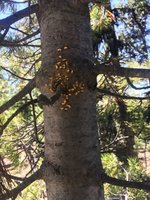jevanlewis
Yamadori
Posting a Whitebark Pine (I think) yamadori I collected (legally) in the Central Cascades in May 2021. It's not a great specimen--it's young and has a very challenging truck that I'll have to get creative with--but it's a chance to learn about a type of Pine I don't have yet. Here are some photos with some questions.
May 15, 2021: Day of collection

June 21, 2021: Pushing new growth

August 5, 2021: The tree is in it's new home (Seattle --> Salt Lake City). The tree continues to push new growth and appears health. The tree starts to show one or two sap spots on the trunk.

August 16, 2021: The foliage remains a health green and the new growth is even stronger. However...

...there are several more sap spots on the trunk.

Anyone have experience with sap spots on the trunk or branches? According to my quick research, while WBP trees are susceptible to Mountain Pine Beetles, generally the beetles don't infect seedlings. It's hard to see with the sap in the way, but there don't appear to be borer/beetle holes, but of course, maybe they can be too small to see easily. Regardless, I've treated the trunk and foliage with Sevin spray and the soil with Bayer insecticide systemic.
I also wonder if the rock under the trunk--not cosmetic; it's just there to hold the trunk up--is baking the trunk in the 90-100 degree weather here in Salt Lake. Today, I removed the rock to see if that helps. Any ideas are appreciated!
May 15, 2021: Day of collection

June 21, 2021: Pushing new growth

August 5, 2021: The tree is in it's new home (Seattle --> Salt Lake City). The tree continues to push new growth and appears health. The tree starts to show one or two sap spots on the trunk.

August 16, 2021: The foliage remains a health green and the new growth is even stronger. However...

...there are several more sap spots on the trunk.

Anyone have experience with sap spots on the trunk or branches? According to my quick research, while WBP trees are susceptible to Mountain Pine Beetles, generally the beetles don't infect seedlings. It's hard to see with the sap in the way, but there don't appear to be borer/beetle holes, but of course, maybe they can be too small to see easily. Regardless, I've treated the trunk and foliage with Sevin spray and the soil with Bayer insecticide systemic.
I also wonder if the rock under the trunk--not cosmetic; it's just there to hold the trunk up--is baking the trunk in the 90-100 degree weather here in Salt Lake. Today, I removed the rock to see if that helps. Any ideas are appreciated!


